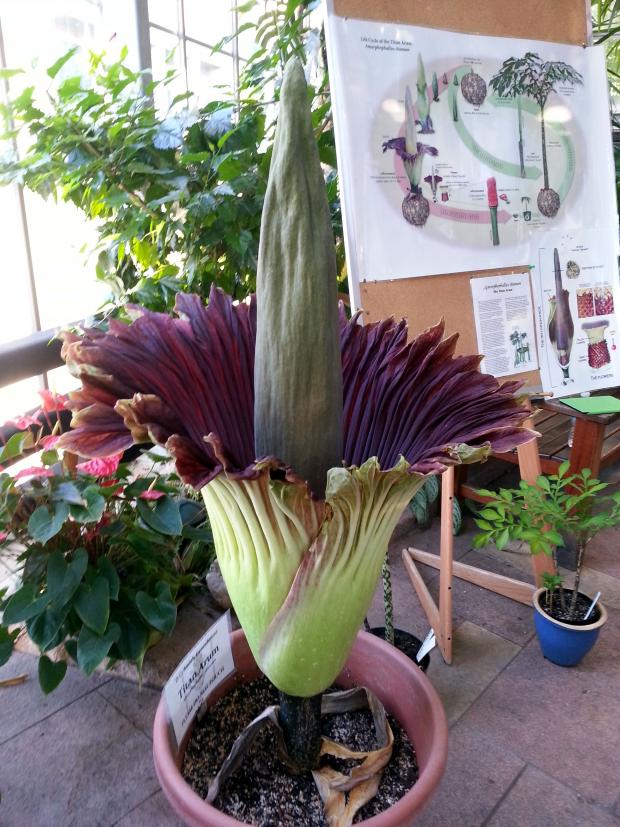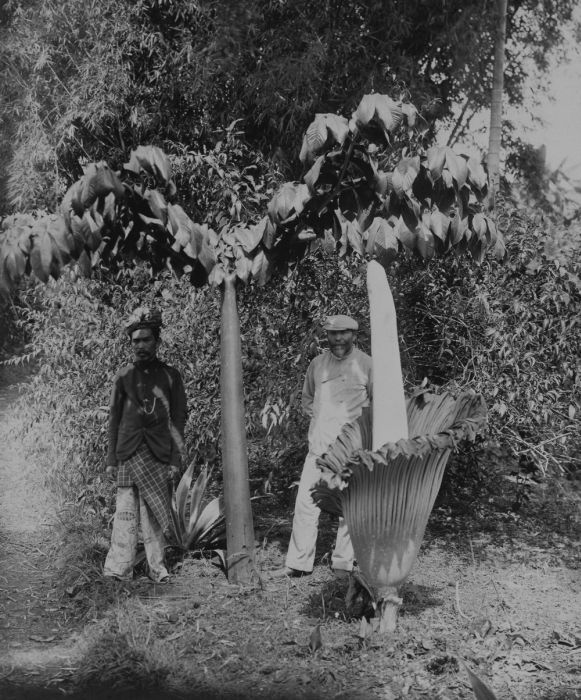The smell factor: Morticia, Putrella, Big Bucky and others.

Fig. 1: Titan Arum in UW-Madison
In Plants and Animals Kingdom all species send each other chemical signals that change their behavior. The signals are used for sexual messaging, tracking, defense and other functions. Beside the visual features that draw attention (such as shape and color) the living organisms mate, feed and attack their enemies upon receiving the signal smells of metabolites, sometimes subtle, sometimes powerful.
Malodorous plants are of a particular interest as they often develop powerful foul smells, and their fleshy appearance often aim to mimic particular animals or their body parts and bodily fluids. These plants are "cheaters and liars of Nature", they demonstrate chemical mimicry at its finest. In many cases, the plants have flowers of extreme size that look like whole large animal carcasses, enhancing the plant’s attractiveness towards flies-pollinators. Possibly, the best examples of such extremities are flowers of Stinking Corpse Lily (Rafflesia arnoldii), the giant inflorescence of the Titan Arum (Amorphophallus titanum) or the Dead Horse Arum (Helicodiceros muscivorus). The plants names are indeed self explanatory.
Such striking creatures of Nature are darlings of any Plants Conservatory or Botanic Garden. Also they are often demanding in terms of cultivation, and many, like giant inflorescence of the Titan Arum, are pretty rare. The Titan Arum plants are endemic to Sumatra and are on display all across the world's conservatories, including one at the DC Smith Greenhouse at the University of Wisconsin-Madison [1]. In an act of pure admiration by spectators such Titan Arum flowers are often personified and called by people or mascot names: Morticia, Morty, Putrella, Velvet Queen, Chanel, and Big Bucky, to name a few.
The Titan Arum produces huge greenish-purple and orange-yellow fleshy bloom that is added by rotten odors of decaying meat or carrion. This attracts carrion beetles and blowflies that are the putative pollinators. The scent emission is further enhanced by a fascinating event of thermogenesis, i.e., auto heating. The scent comes in "overpowering smell of a rotting animal whose corpse is laying in a pan of pickled, cooked cabbage". The waves of odor are synchronized with the plant's heat pulses [2].
The floral scents are composed of small volatile metabolites. The “stench factor” of Titan Arum contains dimethyl trisulfide (that smells like Limburger cheese), dimethyl disulfide, trimethylamine (rotting fish), isovaleric acid (sweaty socks), benzyl alcohol (sweet floral scent), phenol (like Chloraseptic), and indole (like mothballs). Also, isovaleric acid, isovaleraldehyde and methyl thiolacetate were reported among the volatiles [3].

Fig. 2: Titan Arum in Sumatra
The Nature works in a very frugal way, using and re-using the same substances over and over again for many purposes. It is also true for constituents of a flowering Titan Arum's smell:
- Dimethyl mono-, di- and trisulfides are often present in many very smelly plants. They can be found in many Brassicaceous vegetables, especially when overcooked, in volatiles emitted from cooked onion, leek, from broccoli and cabbage. They also contribute to the smell of cheeses like Cheddar and Camembert, and are involved in the unsavory odor of aged beer and stale rice sake.
- Trimethylamine, the smell of rotting fish, is also created in intestines by bacteria breaking the proteins contained in legumes, eggs and fish; a certain breed of Rhode Island Red chicken even produces eggs with a fishy smell, due to particular metabolic route.
- Isovaleric acid (sweaty socks smell) is also the primary cause of the "funky" flavor developed in wine, caused by yeasts. An excess of isovaleric acid in wine is usually taken as a defect, as it smells sweaty, leathery, like a barnyard, but in small amounts it can smell smokey, spicy, or medicinal.
- Flowery benzyl alcohol is found in a variety of essential oils including jasmine, hyacinth, and ylang-ylang. Curiously, it is also one of the chemical compounds found in the castor sacs of the mature North American Beaver, which, in combination with the beaver's urine, is used for scent marking of territory.
- Indole is produced by bacteria during degradation of tryptophan. It occurs naturally in human feces and has an intense fecal odor. However, at very low concentrations it has a flowery smell and found in orange blossoms. Structurally related skatole (its name derived from the Greek root skato- meaning "dung") is found in orange blossoms and jasmine. It is used as a fragrance and fixative - and, surprisingly, in a very small amounts, as a flavouring additive in ice cream. Skatole is one of many compounds that is attractive to males of various species of bee and beetles.
Unlike Corpse Flower of Titan Arum, flowers of other Amorphophallus species produce pleasant odors of bananas and freshly chopped carrots, attributed to presence of isoamyl acetate and 1-phenylethylacetate. Strong flowery aromas are connected to various mixes of linalool, citronellal, farnesol, nerolidol and other terpenes. Taken separately from the plants, in their pure chemical form, they were found to work as pheromones triggering approaching flights of males of insects. The chemical constituents of the odors might also provide clues to the pollinators of plants since, for many species, the pollinators remain a mystery [4].
The NMR spectral data for various terpenoids and benzenoids, aliphatic amines, lipid-derived compounds as well as many other metabolites connected to particular odors, are stored at Metabolomics database at the BMRB. They contain information on 1H, 13C, 13CDEPT90, DEPT135, TOCSY, COSY45, HSQC, HMBC and HSQC-TOCSY-ADIA NMR experiments and related assignments. The data may serve in medical research, food industry, education and laboratory practice.
NMR spectral data for skatole obtained at the Bruker Avance III 500 and presented as the time domain data, the spectra pictures as well as the tables of peak transitions and assigned chemical shifts is assigned the BMRB ID bmse000516.
1. Titan Arum at UW-Madison Conservatory.
2. Barthlott, W., et al, "A torch in the rain forest: thermogenesis of the Titan arum (Amorphophallus titanum).", Plant Biol (Stuttg). 2009 Jul; 11(4): 499-505.
3. Mika Shirasu et al, "Chemical Identity of a Rotting Animal-Like Odor Emitted from the Inflorescence of the Titan Arum (Amorphophallus titanum)", Bioscience, Biotechnology, and Biochemistry Volume 74, Issue 12, 2010.
4. Vereecken, N. J. and McNeil J., N., "Cheaters and liars: chemical mimicry at its finest", Can. J. Zool. 88: 725–752 (2010)
